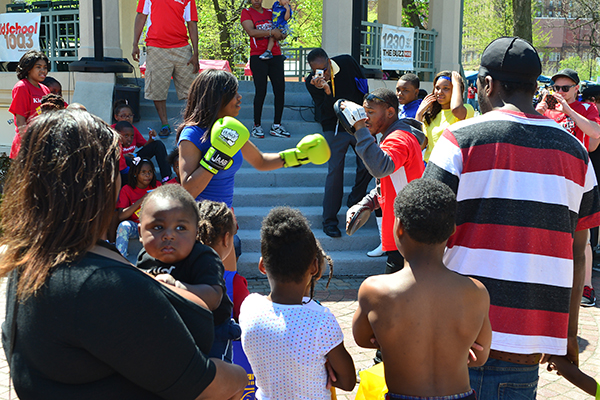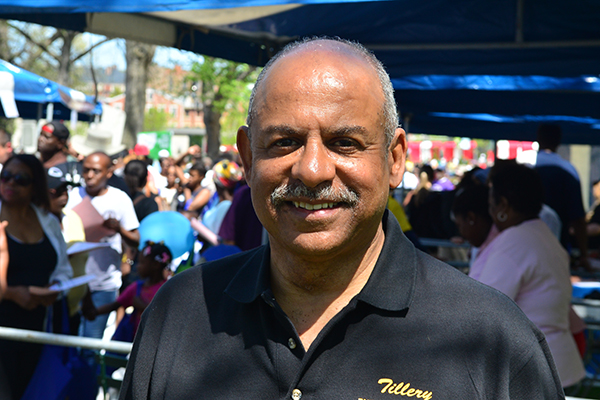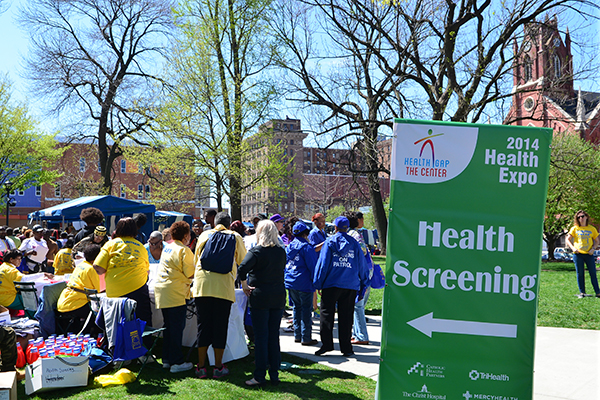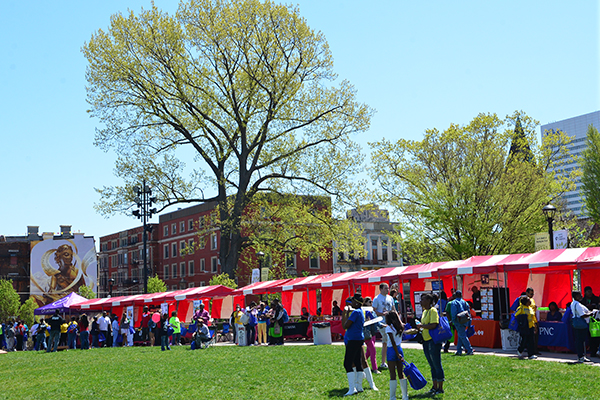Nonprofit groups offer prescription for boosting community health
Cincinnati suffers from a wide disparity in health outcomes, and poverty and race are among the biggest culprits. Yet a network of local organizations is combating the health challenges facing our city.
In Cincinnati, where you live may well determine how long your lifespan will be. Camille Jones, the lead researcher on a Cincinnati Health Department project to measure longevity by neighborhood, knows this all too well. She can tell you the average lifespan of the people who live in your neighborhood.
Living in Lower Price Hill, Camp Washington or Avondale? You’re looking at late 60s. Lucky enough to be hanging in Hyde Park, North Avondale or Columbia Tusculum? You’re more likely to live into your 80s.
Jennifer Chubinski, Interact for Health’s director of community research, points to two lines of research that examine such inequities. Some researchers cite environmental factors that preclude health in individuals. Others cite individual choices that can supercede external challenges. It’s a chicken-and-egg debate.
The truth, according to Chubinski, is somewhere in the middle. But geography is too often destiny, and that’s a problem. “People aren’t looking at the city and choosing randomly where they’re going to live. Some people have choice; some people don’t have choice. When you’re talking about the most vulnerable, they have a lot less choice … their environments tend to be less health promoting.”
Simple measures track health
Greater Cincinnati, overall, is not as healthy as the rest of Ohio. In 2014, Hamilton County ranked 64th out of 88 counties statewide for overall health in the annual Robert Wood Johnson County Health Rankings & Roadmaps report.
Depression, high blood pressure, obesity and high cholesterol are the most common health problems in and around Cincinnati, according to a 2010 community health survey. The study gathered data via phone surveys of 2,246 adults in 22 counties around Greater Cincinnati and was commissioned by Interact for Health (which was called The Health Foundation of Greater Cincinnati at the time).
The bad news is that only half of Cincinnatians say they’re in good health, according to that phone survey. It’s hard to discount that number, too: A 1997 meta-analysis found that self-reported health ratings were highly accurate, even crucial, to understanding individual health.
A question as simple as, “How healthy are you?” prompts people to “think about everything,” Chubuski says. “They understand their full condition, diagnosed or not, and can compare themselves to their peers, family and community to come up with a rating that has proven to be very reliable.”
Poverty plays a part
A glut of data about Cincinnati and the regions surrounding it shows that health and socioeconomic well-being are closely linked. People who make more money and are part of preferenced social groups tend to be healthier. They’re more likely to have access to preventive care to ward off illness. And they’re more likely to seek early, adequate help when they do develop a chronic disease. That might be as simple as filling a maintenance medication or maintaining a relationship with a primary care doctor.
For low-income residents, the numbers look grim. Fewer than 30 percent of adults in Interact for Health’s 2010 community survey living below the federal poverty line described themselves as being in very good or excellent health. Worse, there was no change in that figure over the past decade.
This is where the data becomes murkier. It’s hard to quantify the direct impact of differences in educational attainment, wages, social connections, and even simple trust between people and their physicians. Yet, the inequities persist.
You can see it, after all, in the longevity numbers from the Health Department. “We know that what makes up a healthy community is having social cohesion and greater social heterogeneity in terms of income levels. … We need to figure out what we can do to have greater income improvement in these neighborhoods,” says Noble Maseru, health commissioner for the Health Department. “There won’t be greater longevity without addressing poverty.”
And health inequities are born not just out of poverty, but the compounded effects of various socioeconomic factors, including race, as results of that 2010 community health survey showed.
Addressing mistrust in medicine’s powers
African Americans feel these inequities acutely. With median incomes $20,000 below metropolitan medians, 32 percent of African Americans in and around Greater Cincinnati live in poverty, experiencing double the average unemployment rate.
At home, approximately 20 percent fewer African Americans than whites surveyed in 2010 said they felt safe in their communities. They were also more likely to lack reliable transportation and routine checkups in the past two years.
Dwight Tillery, founder, president and CEO of the Center for Closing the Health Gap, says African Americans are also more likely to be reluctant to visit a hospital or physician’s office. “The distrust that exists, particularly among vulnerable populations, has to do with the historical experience that African Americans have had in this nation,” he says, citing not just slavery, but a legacy of harmful medical experiments performed on low-income and minority patients.
These problems demand a hard look, whether your neighborhood boasts an 85-year average lifespan or is working to correct one in the mid-60s.
“If you have a city that’s sick, it’s not drawing a lot of economic development,” Jones says. Add to that the social cost of allowing low-income and minority groups to develop lingering chronic health problems and a lack of primary care that draws them to costly emergency departments for treatment, and the need for what Jones terms “greater social cohesion” in neighborhoods becomes more clear.
Although challenges abound and structural inequities make it hard to tackle longstanding community health problems, local agencies are making progress in fighting the health care epidemic.
Nonprofits step in
Today, Cincinnati is exploding with nonprofits dedicated to improving community health.
The Center for Closing the Health Gap’s Do Right! Campaign, launched in 2008, addresses community members facing these inequalities. Staffers have already trained 126 community leaders in health leadership, helped fourth graders slash weekly screen time 40 percent and awarded 88 Master Nutrition certifications. Those awardees went on to train 825 others in one year.
Their efforts continued with the Health Gap’s annual Health Expo last weekend at Washington Park. Organizers were expecting about 10,000 attendees.
Holding the expo in a public space, Tillery says, helps attract those who fear traditional medical settings: “It’s not build it, they will come. It’s grassroots. When we reach people, we help them and try to deal with the barriers that keep them from being healthy.” Mayor John Cranley has even lent his name to the cause, pledging his support for ending health inequities.
The Health Gap’s mission is solely focused on eliminating these disparities, says executive director Renee Mahaffey Harris: “By working within the communities and with the people directly dealing with these issues, real change is made.”
The list goes on. The United Way of Greater Cincinnati has identified its “Bold Goals” to improve self-reported health and create medical homes for residents by 2020. And Cradle Cincinnati, a relative newcomer, is tackling infant mortality with some help from Chubinski’s employer, Interact for Health, which also provides funding for dozens of other health-promoting agencies.
Those dozens include Health Care Access Now, which is, as its name suggests, connecting residents to crucial health care. They serve everyone from low-income patients who need help finding affordable prescription refills to new moms and emergency department visitors, who might not have access to reliable primary care.
And don’t forget Jones and her colleagues at the Health Department, who are tracking longevity and mortality with an eye to using neighborhood-level data to spark community interest and local activism.
For individuals faced with her troubling data, Jones offers hope: “Life expectancy is a calculation, not an inherent trait. It’s based on current data. If age-specific mortality rates change — if you have fewer children, infants, adults dying from chronic disease — the calculated life expectancy will change.
“People might think they’re doomed,” she says. “They’re not.”
Robin Donovan is a freelance writer specializing in health and medicine. She recently wrote about Cincinnati MD Jobs, a nonprofit whose mission is to attract and retain medical professional to the Cincinnati area.





















